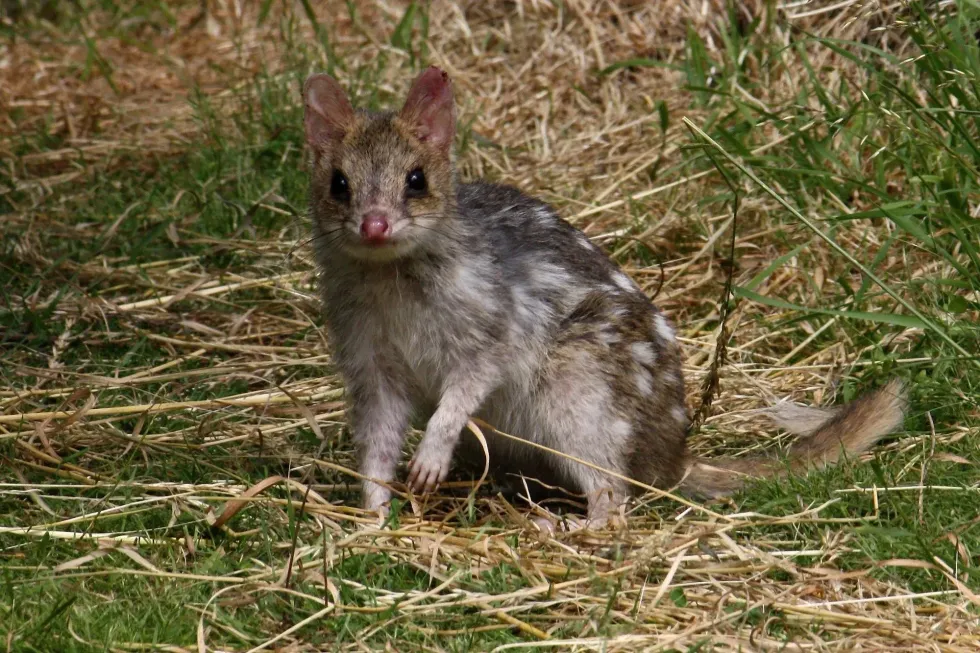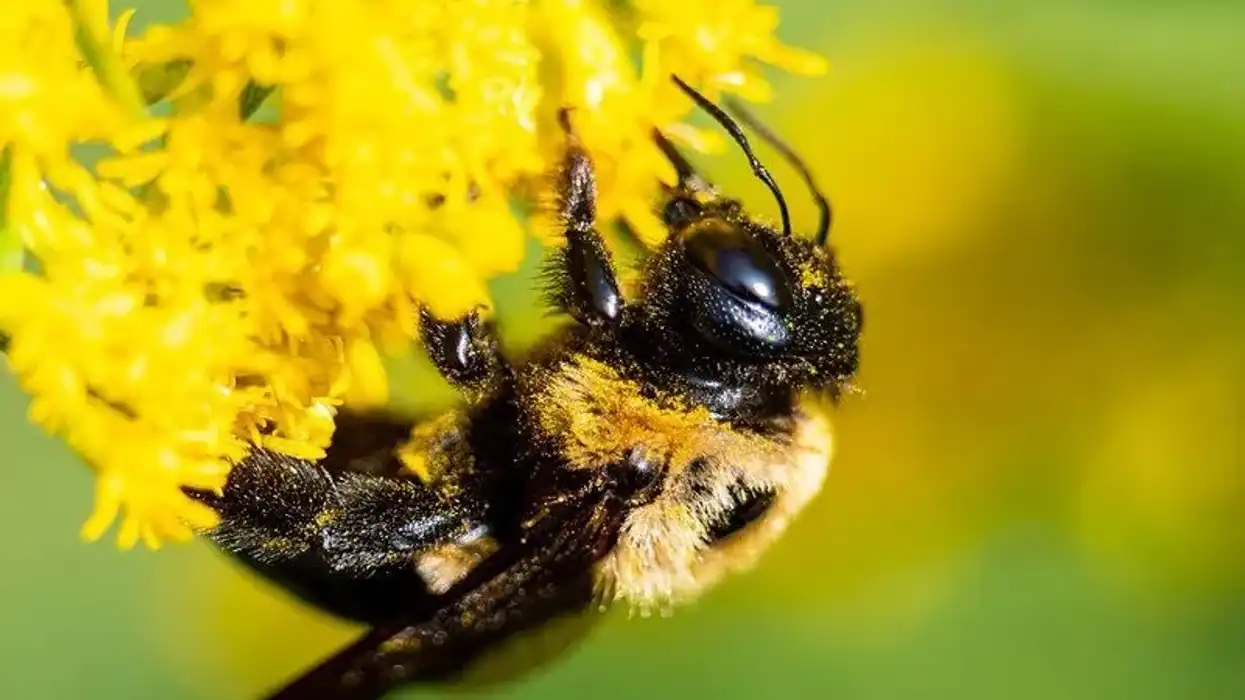Eastern quolls (Dasyurus viverrinus) are medium-sized Australian cats that a have rodent-like mouth. Eastern quolls are of the size of a domestic cat and their body length is around 21-26 in (53.3-66 cm) and their body weight is around 2.4 lb (1.1 kg).
Eastern quoll diet consists of meat mainly. They hunt on small animals during the night time. They are nocturnal animals that spend the day time resting in burrows and hollow logs.
They are solitary in nature. Eastern quolls breed during the start of winter and by the end of winter, they give birth to many pups.
This is just the introduction. Ahead in the article, there are many interesting and funny facts about this animal. Continue reading and you will be amazed!
For more relevant content, read rabbit facts and huskydoodle dog facts for kids.
Eastern Quoll Interesting Facts
What type of animal is an eastern quoll?
The eastern quoll are medium-sized marsupial domestic cats from Australia. They are quolls, similar to northern quolls.
What class of animal does an eastern quoll belong to?
The eastern quoll cat species were once native to the Australian mainland. They belong to the class Mammalia. They are in the infraclass Marsupialia, order Dasyuromorphia, family Dasyuridae and genus Dasyurus. Their scientific name is Dasyurus viverrinus.
How many eastern quolls are there in the world?
According to the IUCN Red List, they are an Endangered species in the threatened category. These wild cats are endemic to the wildlife of Australia. According to the IUCN Red List, there are around 10,000-12,000 individuals alive in mainland Australia.
Where does an eastern quoll live?
Eastern quolls are wild cats that once only lived in mainland Australia. They are a threatened species now. They can be found in forest areas, open lands, and in high-altitude places. The eastern quoll habitat range is decreasing now.
What is an eastern quoll's habitat?
Eastern quolls are marsupial cats once native to the Australian mainland. These animals once inhabited the areas of South Australia in great numbers.
Now their population has decreased but can be still found in south Australia around New South Wales, Victoria, and Adelaide. They have mostly gone extinct from the Australian mainland but are still found in Tasmania. In Tasmania, they are found in forests, alpine areas, open lands, and scrublands.
Who do eastern quolls live with?
The eastern quoll species is mostly solitary in nature. They are wild predators who love hunting alone. They only come together for breeding. They are nocturnal predators who spend their day alone resting in burrows and hollow logs.
How long does an eastern quoll live?
Quoll species are wild predators that live in Tasmania. The eastern quoll life cycle is very short as their lifespan range lies between two to seven years. They are an Endangered species.
How do they reproduce?
Eastern quolls (Endangered) are medium-sized wild marsupial cats that are native to Tasmania. They are a solitary species that come together only for breeding. Their breeding season starts during early winter and lasts for a month. They breed in the first cycle of their breeding season.
After breeding, female quolls go through a gestation period of 19-24 days. After the gestation period, they give birth to 20 young ones. Young quolls achieve their sexual maturity at the age of one.
What is their conservation status?
According to the IUCN Red List, the eastern quoll is an Endangered species in the category of threatened. Around 10,000-12,000 eastern quolls are left in Australia. Their population is preserved in national parks.
Eastern Quoll Fun Facts
What do eastern quolls look like?
Eastern quolls are a marsupial cat species found in Tasmania. Their population is nearly extinct in the mainland of Australia. This cat species is of medium size and these quolls are agile and clumsy.
Their population is preserved in national park areas. Quolls are similar to domestic cat species in size but what separates them is their rodent-like appearance. They have a small head with a tapering snout and standing ears.
Their legs are small and have four fingers, unlike other quolls that have five. These animals have a furry body that is mostly brown in color. On their brown body, they have white spots.
They also have a medium tail. Female quolls have a pouch-like creation that helps and nourishes their young ones. Eastern quoll average body length is between 21-26 in (53.3-66 cm) and their maximum weight is around 2.4 lb (1.1 kg).

How cute are they?
The eastern quoll is very cute and adorable in nature. They are also very cuddly. Unluckily their population count is decreasing, but to alter that, they are kept in national park areas for conservation.
How do they communicate?
The eastern quoll species communicates through a low pitched hiss or a screech sound. They are domestic cat-sized animals found in Tasmania.
How big is an eastern quoll?
The eastern quoll (Tasmania inhabitants) are medium-sized cats with a brown-colored body and white spots on it. Their size is similar to other domestic cats. Their maximum body length is around 21-26 in (53.3-66 cm) and their maximum body weight is around 2.4 lb (1.1 kg).
How fast can an eastern quoll run?
Eastern quolls are a threatened species found in Australia. Quoll species can run at a speed of 15 mph (24.1 kph).
How much does an eastern quoll weigh?
The eastern quoll is a threatened species in Australian wildlife. They are medium-sized predator animals that grow to a maximum length of 21-26 in (53.3-66 cm) and their maximum weight is around 2.4 lb (1.1 kg).
What are the male and female names of the species?
There are no specific names assigned to male or female eastern quolls. However, they show sexual dimorphic characters.
The males have a body length of around 21-26 in (53.3-66 cm) and their weight is around 2.4 lb (1.1 kg). Their body length includes their tail that is 7.9-11 in (20-28 cm). Females have a body length of around 19-23 in (48.3-58.4 cm) and their weight range is around 1.5 lb (0.7 kg).
The tail length of females is around 6.7-9.4 in (17-24 cm). Males are bigger and brighter in appearance than females.
What would you call a baby eastern quoll?
Like all other baby animals, baby or young eastern quolls are known as pups. They grow in the pouch and become sexually mature at the age of one.
What do they eat?
Eastern quolls are mainly carnivorous in nature. They are hunters that roam their habitat at night. They prey on small mammals, insects, and reptiles. They are nocturnal and spend the day resting alone in burrows and hollow logs. Quolls are eaten by feral cats and foxes.
Are they dangerous?
Not really. Eastern quolls are medium-sized cats whose habitat belongs to the wild. In front of humans, they act timid and mostly run away.
Would they make a good pet?
Yes, they are good pets. Eastern quoll pets are very understanding and adorable. They need care and attention from their owners.
Did you know...
Eastern quolls are predators but there are more sharp predators available who hunt them. Most common in the list are Tasmanian devils and masked owls.
What happened to the eastern quoll population?
Distribution of eastern quolls once included major portions of Australia. Nowadays, their population has gone extinct from the Australian mainland. They are now only found in Tasmania. Their population were erased because of excessive predation by feral cats and foxes due to diseases.
Eastern quoll reintroduction efforts
Reintroduction of eastern quolls has been done in Mulligans Flat Woodland Sanctuary. Around 16 individuals were introduced with the help of eastern quoll breeders. This helped to grow their numbers and they became 40 individuals. For their protection, they are kept in national park areas. People there take good care of them.
Here at Kidadl, we have carefully created lots of interesting family-friendly animal facts for everyone to discover! For more relatable content, check out these northern quoll facts and huemul facts.
You can even occupy yourself at home by coloring in one of our free printable eastern quoll coloring pages.
Main image by Ways
Second image by sontag1









